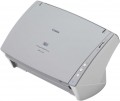Max. resolution
The highest resolution of the digital image generated by the scanner during operation. Specified in dots per inch — dpi (dots per inch).
The higher the scan resolution, the higher the resolution of the resulting image will be (with the same size of the source material) and the more accurately small details will be transmitted on it. On the other hand, high resolution noticeably affects the price of the scanner, increases the processing time and the size of the resulting file — despite the fact that the real need for high detail is not always present, and in some cases it is even unnecessary (for example, when processing an image with small artifacts, not visible at low detail). Therefore, when choosing by this parameter, you should not chase high resolution values — you should proceed from the real need and the specifics of the intended use of the scanner.
The simplest modern scanners have a resolution of about 300x300 dpi — this is quite enough for text recognition with an average font size. And in high-end professional models, this figure can exceed 7000x7000 dpi.
Colour depth (int.)
Under the internal colour depth is meant the number of shades of the image that the scanner itself can recognize; it should not be confused with external depth, which is the amount of hue transmitted to the computer (see below). Colour depth is expressed as the number of bits of information used to encode data about each colour. The total number of colour shades in this case is 2 to the power of n, where n is the colour depth. So, a 24-bit scanner recognizes 16.7 million colours — which is more than one and a half times more than the human eye, and quite enough for simple everyday tasks. In more advanced professional models, colour depth can reach 96 bits. Although the characteristics of the image transmitted to the computer are described by the external colour depth (which can be less than the internal colour depth), the internal depth, however, also affects its quality: other things being equal, a scanner with a higher internal depth provides more accurate colour reproduction.
Mono scanning
The black and white scanning speed provided by the device. Usually, the maximum processing speed for an A4 sheet is indicated, i.e. speed at the lowest resolution. In fact, the speed is usually lower and depends on both the resolution and the size of the original material. The higher the scanning speed, the more convenient it is to work with the scanner; pay special attention to this parameter if you plan to work with numerous black and white images.
Colour scanning
Colour scanning speed provided by the device. In fact, it depends on the selected resolution, colour depth and original dimensions; the characteristics most often indicate the speed for an A4 sheet at the minimum resolution and colour depth, i.e. maximum possible speed. If you only need to scan one or more sheets from time to time, high speed is not too critical, but for working with a large amount of materials, you should look for fast models.
Operating cycle
The maximum number of pages that the scanner can process per day without overloading and the negative consequences associated with them. Most often indicated for A4 format. Even the most modest models of modern scanners have duty cycles measured in dozens of pages, which is quite enough for simple everyday tasks. Therefore, you should pay attention to this parameter if you have to scan numerous materials every day.
Duplex scanning
Availability of
duplex scanning function in the device. Duplex scanning in this case means such an operating mode in which the scanner simultaneously captures an image from both sides of the processed medium (sheet of paper). The convenience of this feature is obvious: the media does not have to be turned over to scan each side separately, and the processing time is significantly reduced. Double-sided scanning is found mainly in the models of traction or combined type (see above), however, there are also flatbed scanners with this capability.
LCD screen
The scanner has its own
display. Such displays can vary from simple indicators that display a minimum of service information (selected mode, work process, some errors, etc.) to full-colour touch screens that significantly expand the capabilities of the device. Anyway, the display makes the operation of the scanner more convenient and intuitive.
Power consumption
The maximum power consumed by the scanner during operation. The higher the power, the more energy the scanner consumes, but this only applies to the scanning process itself — in standby mode, power consumption is negligible. And even at the peak in most models, the power is so low that in fact this parameter has practically no effect on electricity bills and is more of an auxiliary value (for example, it is used to calculate the total power of devices connected to an uninterruptible power supply).

